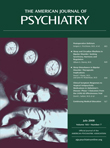To the Editor: Although treatment with antidepressants is associated with a significant reduction in suicides
(1), some patients develop treatment-emergent suicidal ideation following treatment initiation
(2), which has led to a black-box warning by the Food and Drug Administration. Recently, the Sequenced Treatment Alternatives to Relieve Depression (STAR*D) study sample demonstrated associations of genetic polymorphisms within kainate and alpha-amino-3-hydroxy-5-methyl-4-isoxazole propionic acid (AMPA)-glutamate receptors GRIK2 and GRIA3 with treatment-emergent suicidal ideation
(3) . To replicate these findings, we investigated associations between treatment-emergent suicidal ideation and single nucleotide polymorphisms (SNPs) within these two genes in 397 depressed inpatients from the Munich Antidepressant Response Signature (MARS) project.
Suicidal ideation was rated by item 3 (suicide) on the Hamilton Depression Rating Scale (HAM-D) and assessed weekly until discharge, and treatment-emergent suicidal ideation was defined as the onset of suicidal ideation following admission (a score of 0 on item 3 of the HAM-D at admission). The nontreatment-emergent suicidal ideation comparison groups were 1) all individuals without an increase in suicidality, independent of baseline suicidality, and 2) a subgroup of these patients who had a score of 0 on item 3 of the HAM-D throughout treatment.
We genotyped 112 SNPs in GRIK2 and 17 SNPs in GRIA3 using Illumina 300k and 100K BeadChips. Permutation-based allelic and genotypic association tests were applied for SNPs in the GRIK2 gene, and only an allelic test was applied for SNPs in the GRIA3 gene (X chromosomal).
The biomarker rs4825476 within the GRIA3 gene, which was associated with treatment-emergent suicidal ideation in the STAR*D study, was significantly associated with treatment-emergent suicidal ideation in the Munich Antidepressant Response Signature study but with a different risk allele. In the STAR*D study, the SNP within GRIK2 (rs2518224) did not show significant associations in our study sample. However, 15 SNPs in this gene showed nominally significant associations. The genotype distribution of the three best SNPs in the GRIK2 gene and the most significant SNP in both gene GRIA3 and gene GRIK2 that were identified in the STAR*D study is detailed in the table in the data supplement accompanying the online version of this article. Overall, significance was stronger when comparisons were made with the smaller but more strictly defined nontreatment-emergent suicidal ideation group.
Although our results cannot be considered a direct replication of the findings in the STAR*D study, they nevertheless support the involvement of genes GRIA3 and GRIK2 in treatment-emergent suicidal ideation. Permutation-based p values make it less likely that our results were confounded by spurious associations. Within GRIK2, we observed several associations with SNPs, which spanned the gene with negligible linkage disequilibrium. Furthermore, the two best SNPs found in the GRIK2 gene ranked below the top 1,000 (on positions 525 and 693) when all 408,801 SNPs were tested. Finally, using a stricter definition for nontreatment-emergent suicidal ideation, we observed an increase in the strength of association, although power declined.
The divergences found between our study and the STAR*D study may be the result of a series of differences in factors such as study design, outpatient sample versus inpatient sample, citalopram treatment versus the physician’s choice of treatment, and population structure. In addition, the rare risk genotype of rs2518224 (GRIK2), which was strongly associated with treatment-emergent suicidal ideation in the STAR*D study sample, was not present in our treatment-emergent suicidal ideation group. Thus, our sample was not sufficiently powered to detect this effect. However, because of the lack of a placebo group in both studies, treatment-emergent suicidal ideation cannot be directly attributed to antidepressant treatment.
Although preliminary, our study supports the theory that there is a relationship between treatment-emergent suicidal ideation and the glutamate system
(4,
5) . Further large-trial placebo controlled studies on this association are needed in order to establish genetic biomarkers for early identification of patients who are at risk for treatment-emergent suicidal ideation.

